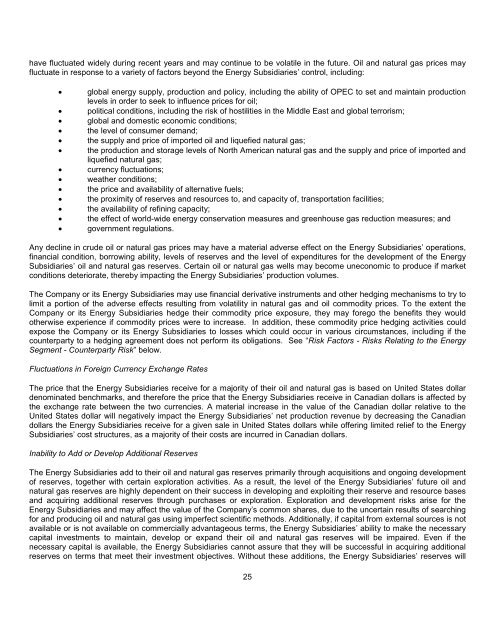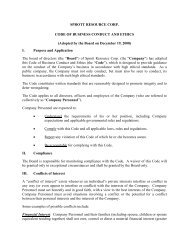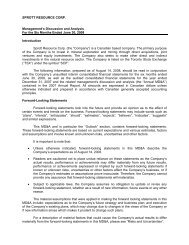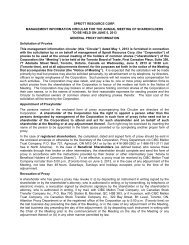AIF - Sprott Resource Corp.
AIF - Sprott Resource Corp.
AIF - Sprott Resource Corp.
You also want an ePaper? Increase the reach of your titles
YUMPU automatically turns print PDFs into web optimized ePapers that Google loves.
have fluctuated widely during recent years and may continue to be volatile in the future. Oil and natural gas prices may<br />
fluctuate in response to a variety of factors beyond the Energy Subsidiaries’ control, including:<br />
• global energy supply, production and policy, including the ability of OPEC to set and maintain production<br />
levels in order to seek to influence prices for oil;<br />
• political conditions, including the risk of hostilities in the Middle East and global terrorism;<br />
• global and domestic economic conditions;<br />
• the level of consumer demand;<br />
• the supply and price of imported oil and liquefied natural gas;<br />
• the production and storage levels of North American natural gas and the supply and price of imported and<br />
liquefied natural gas;<br />
• currency fluctuations;<br />
• weather conditions;<br />
• the price and availability of alternative fuels;<br />
• the proximity of reserves and resources to, and capacity of, transportation facilities;<br />
• the availability of refining capacity;<br />
• the effect of world-wide energy conservation measures and greenhouse gas reduction measures; and<br />
• government regulations.<br />
Any decline in crude oil or natural gas prices may have a material adverse effect on the Energy Subsidiaries’ operations,<br />
financial condition, borrowing ability, levels of reserves and the level of expenditures for the development of the Energy<br />
Subsidiaries’ oil and natural gas reserves. Certain oil or natural gas wells may become uneconomic to produce if market<br />
conditions deteriorate, thereby impacting the Energy Subsidiaries’ production volumes.<br />
The Company or its Energy Subsidiaries may use financial derivative instruments and other hedging mechanisms to try to<br />
limit a portion of the adverse effects resulting from volatility in natural gas and oil commodity prices. To the extent the<br />
Company or its Energy Subsidiaries hedge their commodity price exposure, they may forego the benefits they would<br />
otherwise experience if commodity prices were to increase. In addition, these commodity price hedging activities could<br />
expose the Company or its Energy Subsidiaries to losses which could occur in various circumstances, including if the<br />
counterparty to a hedging agreement does not perform its obligations. See “Risk Factors - Risks Relating to the Energy<br />
Segment - Counterparty Risk” below.<br />
Fluctuations in Foreign Currency Exchange Rates<br />
The price that the Energy Subsidiaries receive for a majority of their oil and natural gas is based on United States dollar<br />
denominated benchmarks, and therefore the price that the Energy Subsidiaries receive in Canadian dollars is affected by<br />
the exchange rate between the two currencies. A material increase in the value of the Canadian dollar relative to the<br />
United States dollar will negatively impact the Energy Subsidiaries’ net production revenue by decreasing the Canadian<br />
dollars the Energy Subsidiaries receive for a given sale in United States dollars while offering limited relief to the Energy<br />
Subsidiaries’ cost structures, as a majority of their costs are incurred in Canadian dollars.<br />
Inability to Add or Develop Additional Reserves<br />
The Energy Subsidiaries add to their oil and natural gas reserves primarily through acquisitions and ongoing development<br />
of reserves, together with certain exploration activities. As a result, the level of the Energy Subsidiaries’ future oil and<br />
natural gas reserves are highly dependent on their success in developing and exploiting their reserve and resource bases<br />
and acquiring additional reserves through purchases or exploration. Exploration and development risks arise for the<br />
Energy Subsidiaries and may affect the value of the Company’s common shares, due to the uncertain results of searching<br />
for and producing oil and natural gas using imperfect scientific methods. Additionally, if capital from external sources is not<br />
available or is not available on commercially advantageous terms, the Energy Subsidiaries’ ability to make the necessary<br />
capital investments to maintain, develop or expand their oil and natural gas reserves will be impaired. Even if the<br />
necessary capital is available, the Energy Subsidiaries cannot assure that they will be successful in acquiring additional<br />
reserves on terms that meet their investment objectives. Without these additions, the Energy Subsidiaries’ reserves will<br />
25





